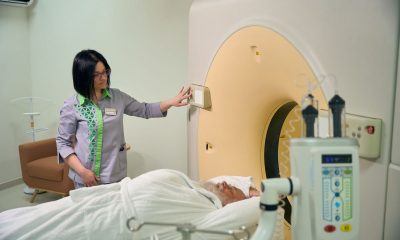Sciatica
Can Endometriosis Cause Sciatica Pain

If you suffer from leg pain, you may be wondering if endometriosis can cause sciatica pain. You may also wonder how serious this condition is, how it’s treated, and what symptoms you might experience. This article will discuss the signs and symptoms of endometriosis, how you can identify it, and the best treatment options.
Is Sciatica Common With Endometriosis?
There are various causes of sciatica, and it is not always clear if it is related to endometriosis. Sometimes, it occurs during the menstrual cycle; other times, it may be constant or sporadic. In these cases, the condition is cyclic sciatica, and the pain can fluctuate with hormonal changes.
In sciatica, a patient may experience lower back pain that radiates down one or both legs. This pain can become so severe that it interferes with gait and overall mobility. Patients may have trouble walking, limp toward one side, or report muscle weakness or paralysis.
If you suspect you have endometriosis and suffer sciatic pain, it is best to consult your doctor immediately. It is common for a woman to experience pain and numbness in the leg. You may also experience numbness or tingling in the leg, which could indicate endometriosis.
The treatment for sciatic endometriosis varies from patient to patient. Sometimes, the condition responds well to hormonal therapy and doesn’t require surgery. However, in other cases, a woman may need surgical excision of the endometrial tissue.
How Is Sciatic Endometriosis Treated?
People with sciatic endometriosis suffer from pain along the sciatic nerve, which connects the spinal cord to the legs and feet. It runs from each side of the lower spine and through the back of the thigh to the foot. Endometriosis presses on this nerve, which causes pain, numbness, and muscle weakness. It also affects the ability to walk, negatively impacting a woman’s quality of life.
Diagnosing sciatic endometriosis begins with a comprehensive examination of the pelvic wall. A neuropelveological examination, which includes a digital examination, sonography, and the Hoffmann-Tinel sign, is often used to make a diagnosis. In some cases of sciatic endometriosis, the pelvic wall and sciatic nerve can be examined more closely through laparoscopy.
Treatment depends on the extent of the damage to the nerve and the severity of the symptoms. Some patients may experience neuropathic pain or motor disorders following surgery. However, these effects are temporary and will improve over time. After three to five years, the function of the sciatic nerve regains a normal level. Rehabilitation is important to enabling patients to return to walking without difficulty.
Is Sciatic Endometriosis Serious?
If you’re experiencing leg pain, you may have endometriosis in the sciatic area. While this condition is not life-threatening, it can cause severe pain. It is important to get a proper diagnosis from a medical doctor to receive the proper treatment.
It is recommended to determine if endometriosis is the underlying cause of your sciatic pain.
The pain is often felt during or after menstruation and can interfere with walking. It can be intermittent or persistent and lasts for several days. It may also cause leg, ankles, or foot pain and alter the patient’s reflexes or gait.
Although endometriosis usually affects the pelvic area, it can affect distant areas such as the brain, lungs, gastrointestinal tract, and urinary tract. It can even affect the pelvic cavity or the cervix. Symptoms of endometriosis may include painful urination, pelvic pain, and pain during intercourse. In some cases, the pain can last for up to 48 hours after intercourse.
The diagnosis of sciatic nerve endometriosis is usually made through an MRI of the lumbosacral plexus. A doctor may also order an MR neurography to identify if a patient has deep endometriotic foci in the gluteal region. Additionally, MRIs can detect Wallerian degeneration, a condition associated with severe axonal nerve damage.
What Kind Of Leg Pain Does Endometriosis Cause?
Endometriosis can cause leg pain, which often feels like a throbbing sensation. This pain is most common in the lower legs and can worsen during or immediately after a period. It can also affect the hips and butt. This pain is caused by pressure on the sciatic nerve, which travels from the lower back down the leg.
Endometriosis can also affect the sciatic nerve, which travels from the lower back to the lower legs. This abnormal growth can put pressure on the nerve and cause pain. Endometriosis is a condition that requires prompt diagnosis from a qualified physician. Fortunately, the condition can be treated and managed with the right treatment. If left untreated, endometriosis can progress into chronic leg pain.
Pain in the legs can be difficult to diagnose, so you should visit your doctor to make sure you’re not suffering from another medical problem. In fact, up to 50% of women with endometriosis experience leg pain. Because it affects the pelvic nerves, endometriosis leg pain can be difficult to identify and treat. However, you can take some simple steps to manage the pain.
How Is Sciatic Endometriosis Diagnosed?
The first step in diagnosing sciatica is determining the source of the pain. The sciatic nerve is one of the body’s largest nerves, running from the spinal cord to the lower legs and feet. Endometriosis places pressure on this nerve, causing leg pain, numbness, and pain that can make walking difficult. Some women have leg pain so severe that they limp or even become paralyzed.
A physician will perform a pelvic examination to determine the cause if symptoms are present. In addition, a laparoscopic exploration of the sciatic nerve area is often necessary to diagnose the condition. This procedure can reveal endometrial stromal cells that are distinguishable from normal cells.
After confirming a diagnosis of endometriosis, your doctor may recommend an MRI. This minimally invasive procedure takes about 10 minutes and requires the patient to lie still for the procedure. A CT scan may be useful if the disease is isolated from the sciatic or sacral nerve root. Fortunately, this patient underwent surgery, which provided her with complete pain relief. She was examined again at 12 months and still had no recurrence of symptoms.
Pain in the pelvic area may also be a sign of endometriosis. A pelvic exam may show no abnormalities, but a pelvic ultrasound may detect the disease. The pain may be located in the buttocks or the legs. It can take a couple of days for the pain to be noticed, but your doctor will most likely diagnose the condition after a few days.
What Are The Rare Symptoms Of Endometriosis?
Endometriosis is a disease of the uterus that can affect women’s menstrual cycles and cause painful bowel movements. The pain during menstruation can worsen on days before and after a period and can be so severe that it interferes with a woman’s ability to carry out regular activities. The symptoms can be difficult to spot because they can be similar to other conditions or diseases. However, recognizing a symptom is important for advocating for your health and speaking up when necessary.
The most common symptoms of endometriosis include pelvic and lower abdominal pain during periods and intercourse. Women can also experience pain during bowel movements and bladder problems. These symptoms are usually chronic and may increase or decrease with the menstrual cycle. Some women may experience blood in the urine or bowel movements. Occasionally, women may experience pain in the chest or anus.
Endometriosis can impact a woman’s ability to become pregnant. While some women with endometriosis can become pregnant after having surgery, others will never be able to conceive. Those women may need to undergo assisted reproductive treatments.
What Does Endo’s Belly Feel Like?
Endometriosis causes bloating, which can be quite painful. The symptoms are usually temporary but can last up to 48 hours. Sometimes, you may go to sleep with a Santa Claus belly and wake up with a normal stomach. See a doctor if you have bloat that persists for longer than a day.
You may experience pain in your abdominal region, which can be easily relieved with a hypopressive breathing technique. The problem is that this breathing method can make you look and feel odd. You may also experience an endo belly if you have an opportunistic infection. However, this is rare and is not the primary cause of endometriosis.
There are several ways to treat endometriosis. The first step is to rest. Taking anti-inflammatory medication can help reduce the symptoms. Another approach is to eat a balanced diet. Try to include fresh fruit and vegetables, nuts, and seafood. Avoid sugar, caffeine, and alcohol, as these foods can aggravate inflammation.
Another way to relieve endometriosis symptoms is to consult a doctor. Endometriosis can also cause gastrointestinal problems, including nausea and bloating. Endometriosis can also cause heavy bleeding and chronic pelvic pain.
Conclusion
There is almost always a history of pelvic endometriosis. Left untreated, sciatic endometriosis may cause nerve damage. Only large nodules invading nerves can be detected upon magnetic resonance imaging (MRI). Magnetic resonance imaging evidence for the perineural spread of endometriosis to the lumbosacral plexus. A doctor typically begins by asking questions to help identify the cause. Next, they may ask about more typical endometriosis symptoms. When endometriotic tissue grows on the sciatic nerve fiber, usually in the area around the sciatic notch in the upper part of the hip bone, it can lead to what is known as sciatic endometriosis.

Doctor Osvaldo Pepa, Neurosurgery Service Physician at Hospital San Martin, La Plata, Argentina. I graduated last November 16, 1984 with a Medical Degree at the Universidad Nacional de La Plata. The Medical Board of La Plata, District 1, licensed me as a Neurosurgeon in 1990. I hold a Provincial and National License and an active member of the Neurosurgery Society of La Plata, World Ozone Therapy Federation, and Inter American Society of Minimally Invasive Surgery.

























